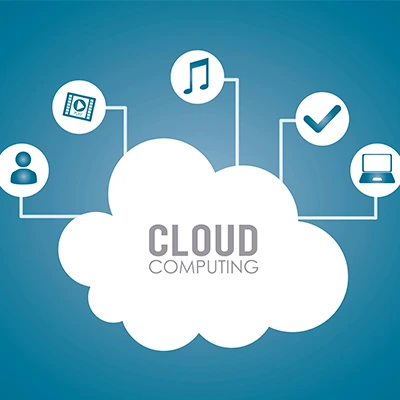Cloud Computing is a technology that involves delivering various computing services over the internet. Instead of owning physical hardware and software resources, users and organizations can access and utilize these resources as on-demand services from remote data centers. These services can include computing power, storage, databases, networking, software, analytics, and more.
Definition of Cloud Computing
Cloud computing is a technology paradigm that involves delivering a wide range of computing resources and services, including computing power, storage, databases, networking, software, and analytics, over the internet. Users and organizations can access and utilize these resources on-demand, without the need to own or maintain physical hardware and software. Cloud computing offers scalability, flexibility, and cost-efficiency by allowing users to pay for the resources they use and to easily scale their computing capacity up or down as needed. It is provided through various service models, such as Infrastructure as a Service (IaaS), Platform as a Service (PaaS), and Software as a Service (SaaS), enabling users to focus on their applications and services while leaving infrastructure management to cloud providers.
Types of Cloud Computing
Cloud Computing can be categorized into different types based on the service models and deployment models.
The main service models are:
- Infrastructure as a Service (IaaS): IaaS provides virtualized computing resources over the internet. Users can rent virtual machines, storage, and networking components on a pay-as-you-go basis. They have more control over the underlying infrastructure and can install and manage their own operating systems and applications. Examples of IaaS providers include Amazon Web Services (AWS) EC2, Microsoft Azure Virtual Machines, and Google Cloud Compute Engine.
- Platform as a Service (PaaS): PaaS offers a platform and environment for developers to build, deploy, and manage applications without worrying about the underlying infrastructure. It includes tools, development frameworks, and middleware that simplify the application development process. PaaS users focus on coding and application logic, while the platform manages scalability, security, and maintenance. Examples of PaaS offerings are Google App Engine, Microsoft Azure App Service, and Heroku.
- Software as a Service (SaaS): SaaS delivers software applications over the internet on a subscription basis. Users can access these applications through web browsers, without needing to install or maintain the software locally. SaaS covers a wide range of applications, from email and office productivity suites to customer relationship management (CRM) and enterprise resource planning (ERP) systems. Examples include Google Workspace, Microsoft 365, Salesforce, and Dropbox.
Deployment models classify cloud services based on where and how they are deployed:
- Public Cloud: Public clouds are owned and operated by third-party cloud service providers. Resources are shared among multiple users and organizations, and services are accessible over the internet. Public clouds offer high scalability and cost-effectiveness, making them suitable for a wide range of applications and users.
- Private Cloud: Private clouds are dedicated to a single organization and can be hosted on-premises or by a third-party provider. They offer more control over security, customization, and compliance, making them suitable for organizations with specific regulatory requirements or sensitive data.
- Hybrid Cloud: Hybrid clouds combine public and private cloud resources. This allows organizations to take advantage of the scalability and cost-efficiency of public clouds while keeping certain sensitive or critical workloads on private infrastructure. Hybrid clouds enable seamless data and application portability between different environments.
- Multi–Cloud: Multi-cloud strategies involve using services from multiple cloud providers to avoid vendor lock-in, enhance redundancy, and optimize costs. Organizations may choose specific providers for different services based on their strengths and offerings.
These service and deployment models provide a spectrum of options for organizations and individuals to choose the cloud computing approach that best aligns with their needs, preferences, and technical requirements.

Scope of Cloud Computing
The scope of cloud computing is extensive and continues to evolve as technology advances. Cloud computing has transformed how businesses and individuals approach computing resources and services.
Its scope encompasses various aspects, including
- Infrastructure: Cloud computing provides virtualized infrastructure resources like virtual machines, storage, and networking. This enables organizations to easily scale up or down, reducing the need for large upfront investments in hardware.
- Application Development and Deployment: Cloud platforms offer tools, development frameworks, and services that streamline application development, testing, deployment, and management. Developers can focus on coding rather than dealing with underlying infrastructure.
- Data Storage and Management: Cloud storage services allow users to store and manage data without worrying about hardware maintenance. Scalable and reliable storage options cater to different data needs, from simple file storage to more complex database management.
- Software Delivery: Software as a Service (SaaS) delivers applications over the internet, eliminating the need for local installations and updates. Users can access software from any device with an internet connection.
- Big Data and Analytics: Cloud platforms provide powerful tools for processing and analyzing large datasets, enabling businesses to extract valuable insights from their data.
- Artificial Intelligence and Machine Learning: Cloud services offer AI and machine learning resources that allow organizations to develop and deploy AI-powered applications and algorithms without extensive hardware requirements.
- Internet of Things (IoT): Cloud computing provides the infrastructure needed to collect, process, and analyze data from IoT devices, enabling innovative applications and services.
- Security and Compliance: Cloud providers invest in robust security measures and compliance certifications to protect user data. However, it’s essential for users to implement their own security practices.
- Remote Work and Collaboration: Cloud-based tools and platforms enable remote work and collaboration, allowing teams to work together regardless of their physical location.
- Disaster Recovery and Business Continuity: Cloud-based disaster recovery solutions offer redundancy and backup services to ensure data availability in case of unexpected incidents.
- Cost Optimization: Cloud computing’s pay-as-you-go model allows businesses to optimize costs by only paying for the resources they use, avoiding over-provisioning.
- Global Reach: Cloud services are accessible from anywhere with an internet connection, making them suitable for organizations with a global presence.
- Innovation: Cloud computing fosters innovation by reducing the barriers to experimentation and development. Startups and small businesses can access the same technologies that were previously reserved for larger enterprises.
As cloud technology continues to evolve, its scope is likely to expand further, incorporating new technologies like edge computing, serverless computing, and quantum computing. This expanding scope offers opportunities for businesses to transform their operations, enhance their agility, and drive innovation. However, it also brings challenges in terms of security, data privacy, vendor lock-in, and optimal resource management that need to be carefully considered and managed.
Benefits of Cloud Computing
Cloud computing offers numerous benefits to individuals and organizations across various sectors.
Some of the key benefits include:
- Scalability: Cloud services provide the ability to scale resources up or down based on demand. This flexibility allows businesses to handle fluctuations in workloads and avoid over-provisioning, which can lead to cost savings.
- Cost Efficiency: Cloud computing follows a pay-as-you-go model, where users pay only for the resources they use. This eliminates the need for significant upfront investments in hardware and reduces operational costs related to maintenance and upgrades.
- Accessibility: Cloud services can be accessed from anywhere with an internet connection. This enables remote work, collaboration among distributed teams, and access to applications and data on various devices.
- Flexibility: Cloud computing offers a wide range of services and resources that cater to diverse needs, from simple storage to complex data analysis and machine learning.
- Rapid Deployment: Cloud services can be provisioned quickly compared to traditional IT infrastructure, allowing businesses to roll out new applications and services more efficiently.
- Innovation: Cloud computing provides access to advanced technologies like artificial intelligence, machine learning, and big data analytics. This enables organizations to innovate and develop new applications and services.
- Automatic Updates: Cloud providers handle software updates, security patches, and infrastructure maintenance, reducing the burden on IT teams and ensuring that applications remain up to date and secure.
- Global Reach: Cloud services are accessible from multiple geographic locations, enabling businesses to expand their operations and serve customers in different regions.
- Disaster Recovery: Cloud-based backup and recovery solutions offer data redundancy and disaster recovery capabilities, ensuring business continuity in case of unexpected incidents.
- Resource Efficiency: Cloud providers optimize resource utilization by pooling resources across multiple users. This leads to better resource efficiency compared to traditional on-premises infrastructure.
- Environmental Impact: Cloud computing can be more environmentally friendly by optimizing resource usage and energy consumption. Cloud data centers often implement energy-efficient practices.
- Reduced Complexity: Cloud services abstract the complexities of managing hardware and infrastructure, allowing businesses to focus more on their applications and services.
- Elasticity: Cloud resources can be rapidly adjusted to meet varying workloads, ensuring optimal performance during peak usage times.
- Collaboration: Cloud-based tools and platforms enable seamless collaboration among teams by providing shared access to documents, applications, and communication tools.
- Competitive Advantage: Cloud adoption can lead to faster time-to-market for new products and services, giving businesses a competitive edge.
- Accessibility to Small Businesses: Cloud computing levels the playing field for small businesses, allowing them to access technologies and resources that were previously out of reach due to cost constraints.
While cloud computing offers numerous advantages, it’s important to consider factors like security, data privacy, vendor lock-in, and regulatory compliance when adopting cloud services. Organizations should carefully assess their needs and choose the right cloud solutions that align with their business objectives.

Why is it called cloud computing?
The term “cloud computing” is used to metaphorically describe the delivery of computing resources and services over the internet. The term “cloud” in this context is a representation of the complex and often abstract nature of the internet and the various interconnected networks that make up the global communication infrastructure.
The concept of using a cloud-like symbol to represent the internet dates back to network diagrams and illustrations in the 1960s. In these diagrams, when the specifics of the network infrastructure were not relevant, a cloud symbol was used to represent the larger network, which was typically the internet.
The term “cloud computing” gained prominence in the early 2000s as the technology and practice of delivering computing resources over the internet began to evolve and become more widely adopted. The cloud symbol was then used to signify the idea of providing various computing services, such as storage, processing power, and applications, from remote data centers accessed via the internet.
So, in essence, “cloud computing” refers to the idea that computing resources and services are delivered from a “cloud” or a network of interconnected servers, with the specifics of the underlying infrastructure being abstracted away from users and consumers of these services. The term captures the notion of accessing computing power and services without needing to understand or manage the physical hardware and infrastructure.
How cloud computing works?
Cloud computing works by delivering various computing services over the internet using a network of remote data centers. These services are provided by cloud providers, such as Amazon Web Services (AWS), Microsoft Azure, and Google Cloud Platform (GCP). The basic working principles of cloud computing include:
- Virtualization: Cloud providers use virtualization technologies to create virtual instances of computing resources like servers, storage, and networking components. Virtualization allows multiple users to share physical hardware while maintaining isolation and security.
- Service Models: Cloud computing offers different service models: Infrastructure as a Service (IaaS), Platform as a Service (PaaS), and Software as a Service (SaaS). These models dictate the level of control and management users have over the underlying infrastructure.
- Deployment Models: Cloud services can be deployed in different ways: public cloud, private cloud, hybrid cloud, and multi-cloud. These models determine how resources are hosted and managed.
- User Interaction: Users interact with cloud services through web browsers, applications, and APIs (Application Programming Interfaces). These interfaces allow users to request and manage computing resources, data storage, and applications.
- Resource Provisioning: Users request computing resources such as virtual machines, storage space, or databases from the cloud provider. Resources can be provisioned dynamically, allowing users to scale up or down based on demand.
- Resource Management: Cloud providers manage and allocate physical resources across multiple users and applications, ensuring efficient utilization and optimal performance.
- Data Centers: Cloud providers operate data centers with extensive infrastructure, including servers, storage arrays, networking equipment, and cooling systems. These data centers are geographically distributed to enhance availability and performance.
- Networking: Cloud services rely on robust networking infrastructure to deliver data and applications to users. This includes load balancing, content delivery networks (CDNs), and secure communication protocols.
- Security and Compliance: Cloud providers implement security measures to protect user data, including encryption, access controls, and compliance certifications. However, users also have a responsibility to implement security practices on their end.
- Elasticity and Scalability: Cloud services offer elasticity, which means resources can be automatically scaled up or down based on demand. This helps maintain optimal performance during peak usage times.
- Service Level Agreements (SLAs): Cloud providers offer SLAs that outline the level of service, uptime guarantees, and support options. Users can choose services that align with their requirements.
- Pay-as-You-Go Model: Cloud services operate on a pay-as-you-go or subscription basis. Users are billed based on their usage of resources and services.
- Automatic Updates: Cloud providers manage software updates and security patches, ensuring that applications and infrastructure remain up to date and secure.
In summary, cloud computing leverages virtualization, remote data centers, and a variety of service and deployment models to deliver computing resources and services over the internet. This approach offers users flexibility, scalability, cost savings, and ease of management, transforming the way organizations and individuals use and manage technology.





